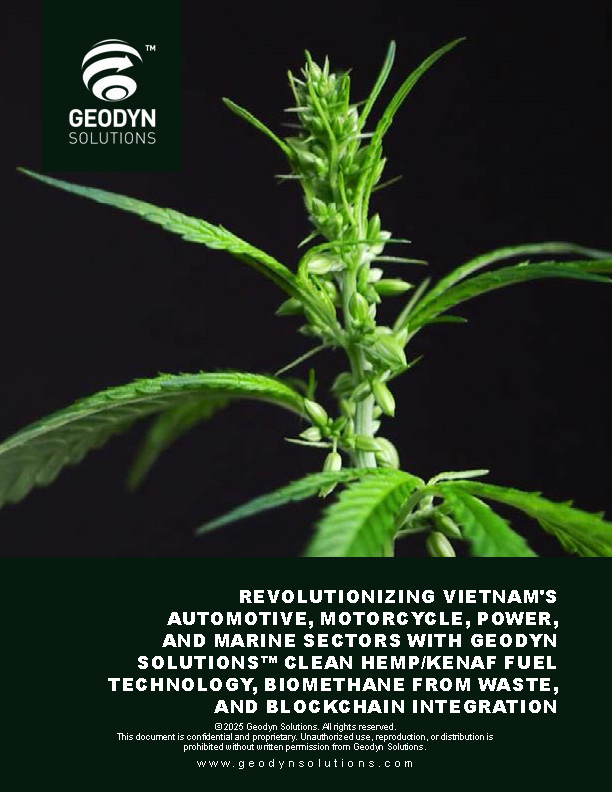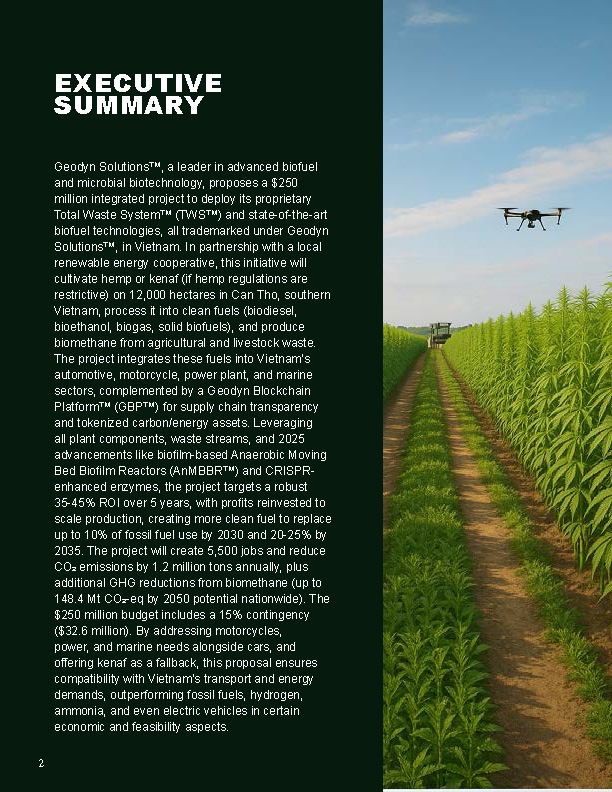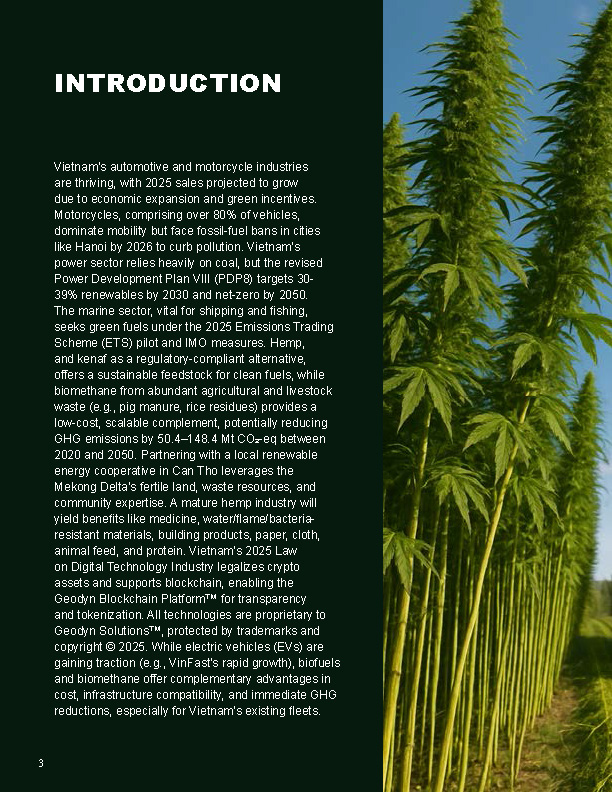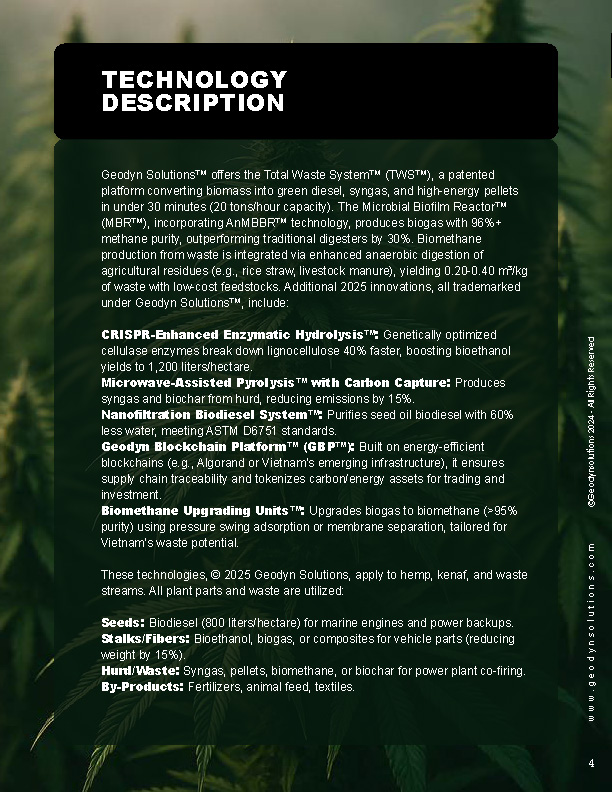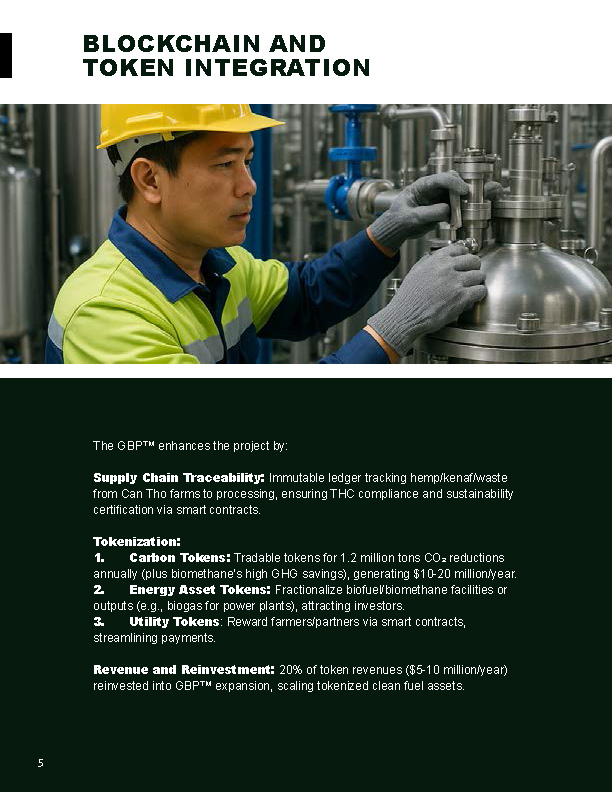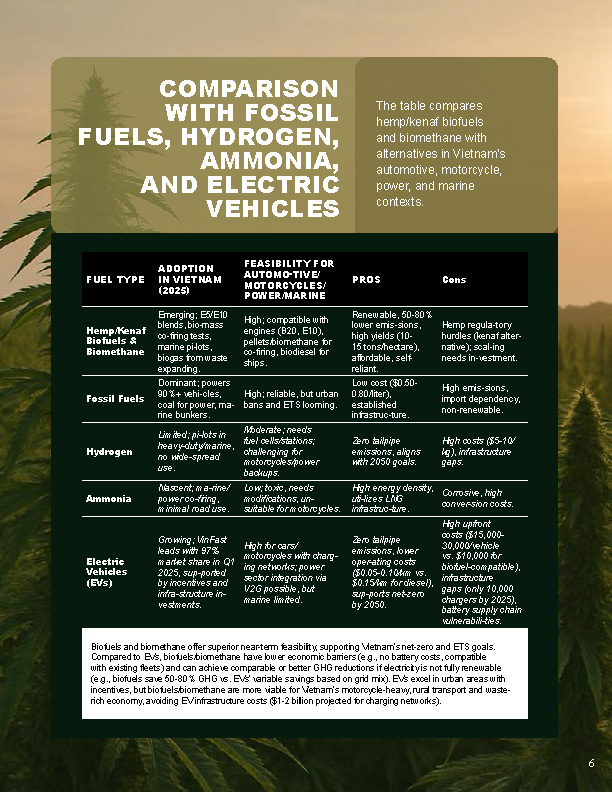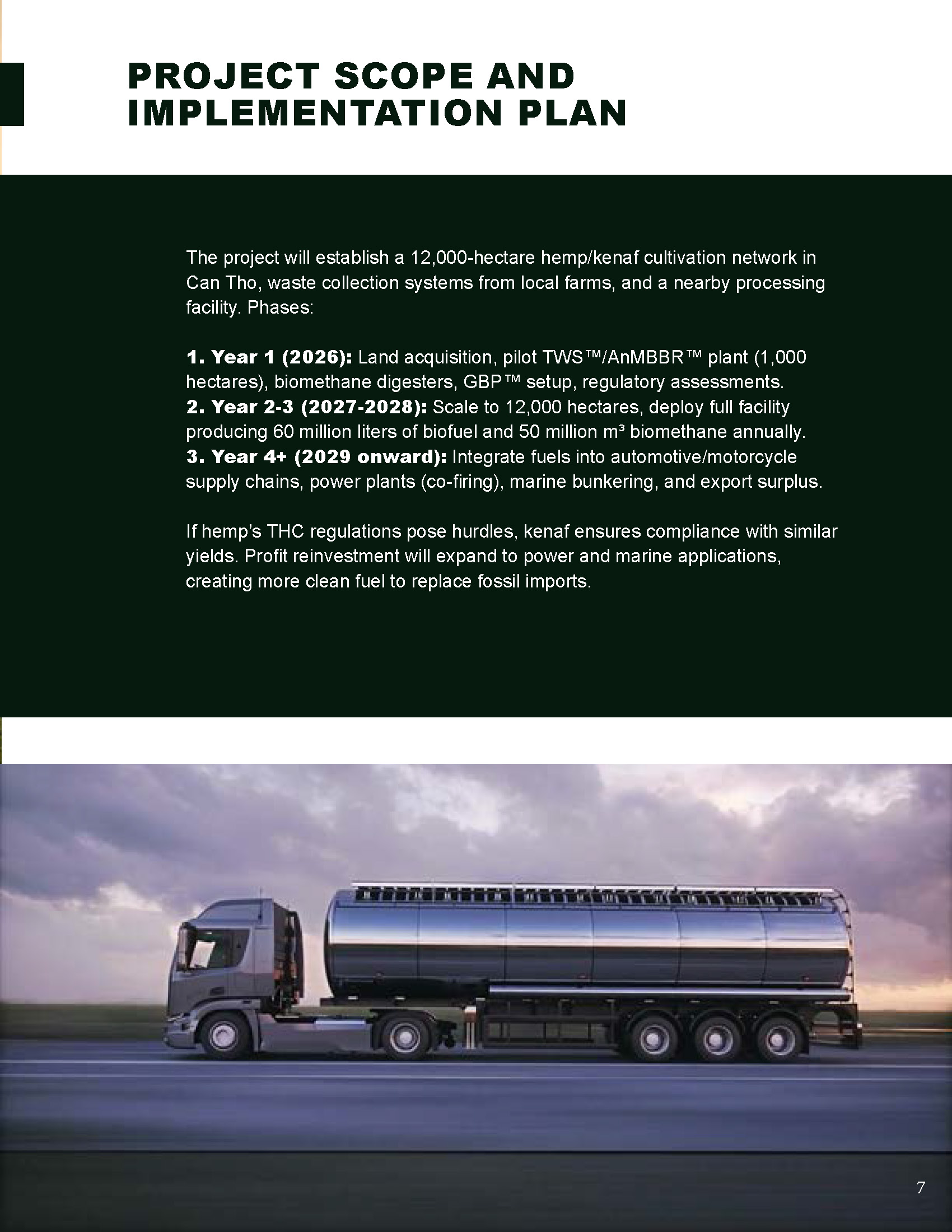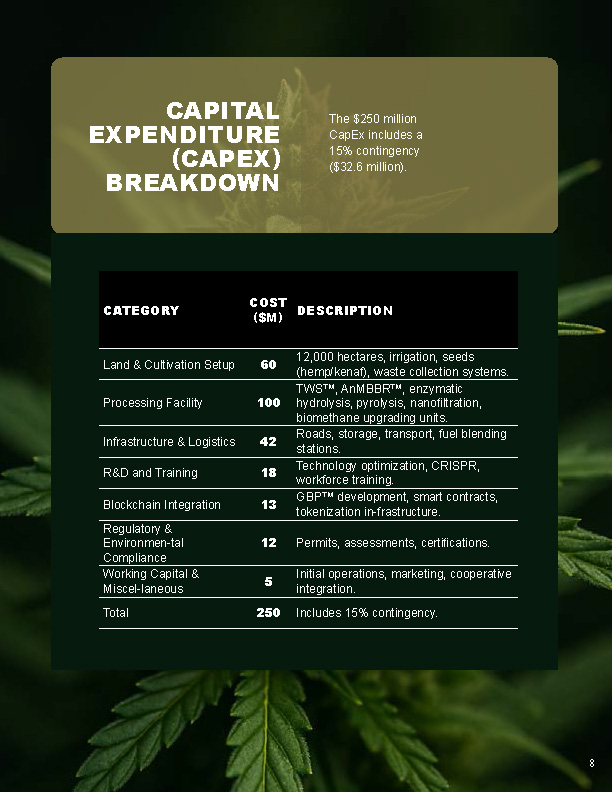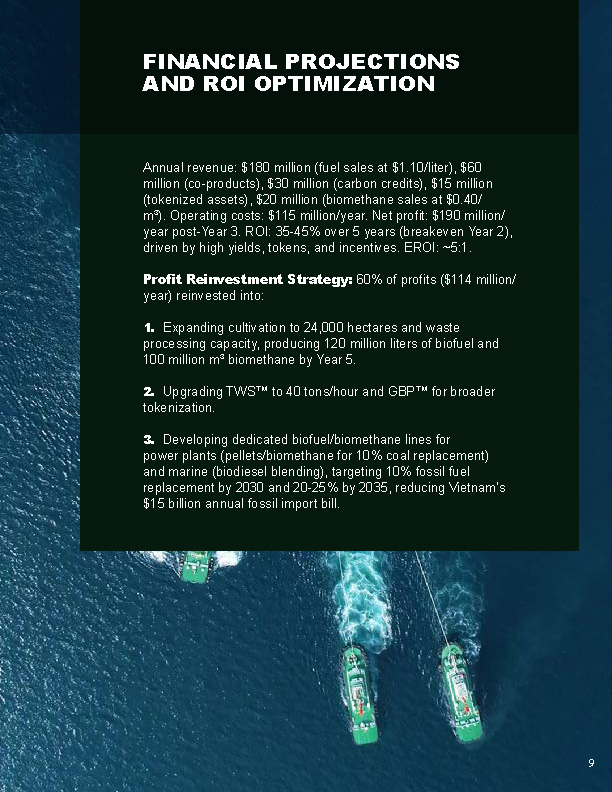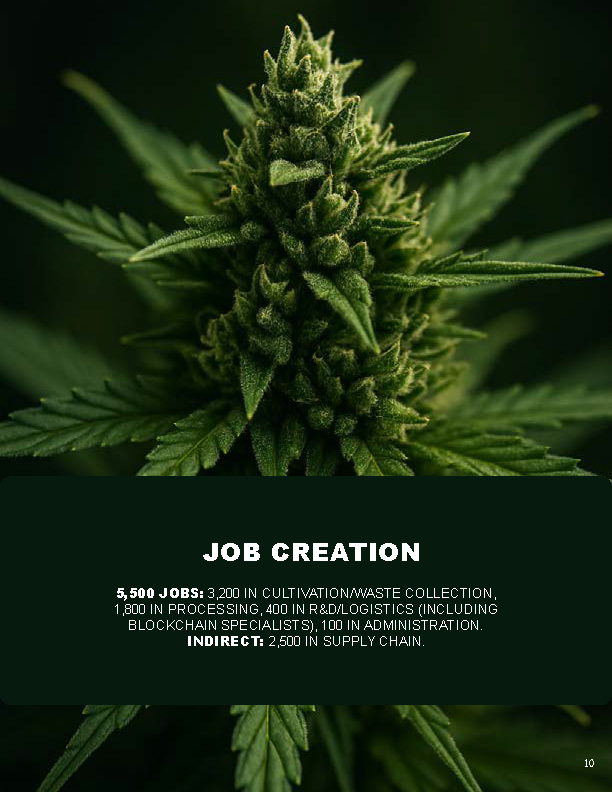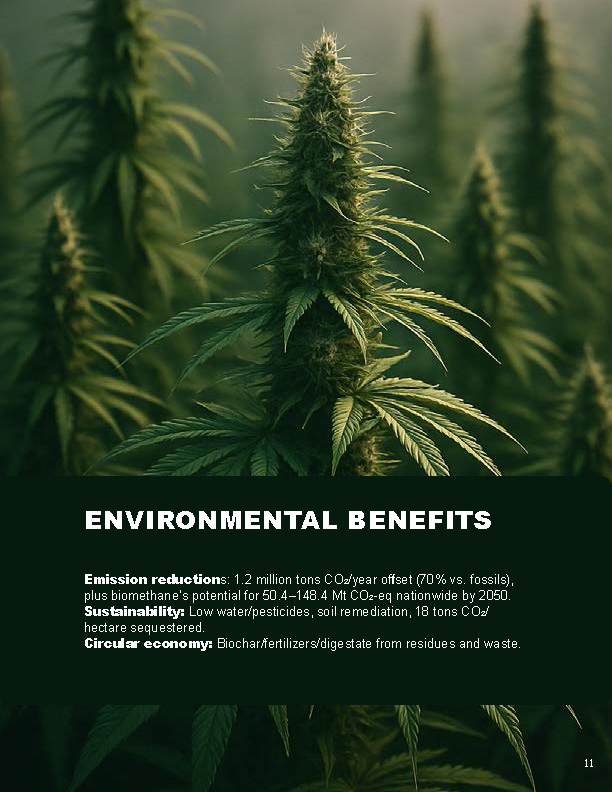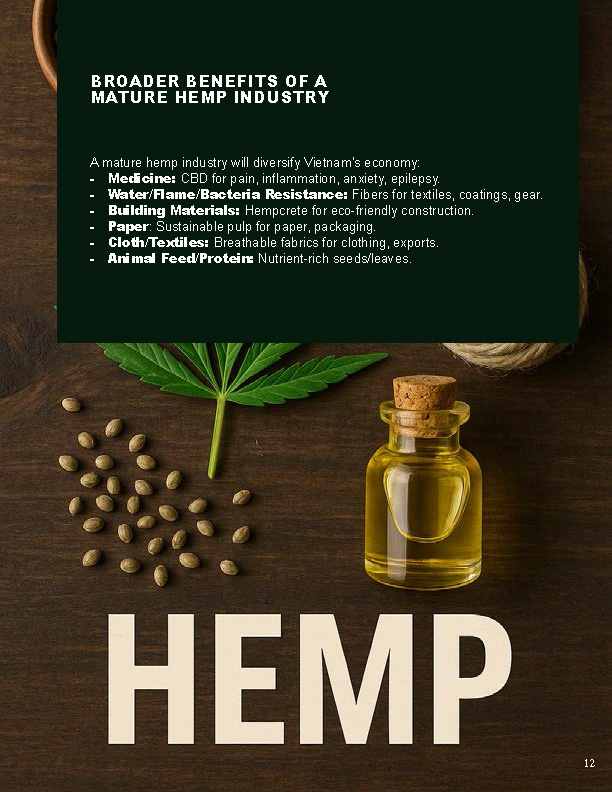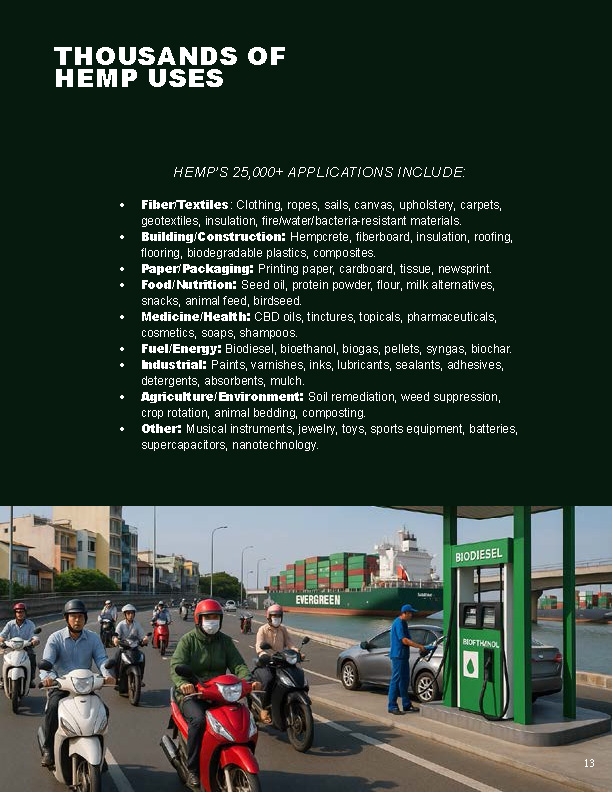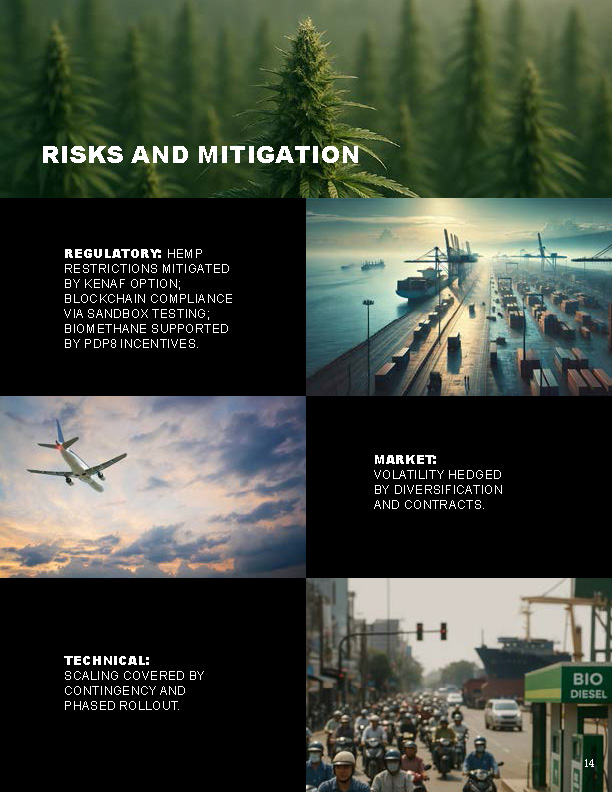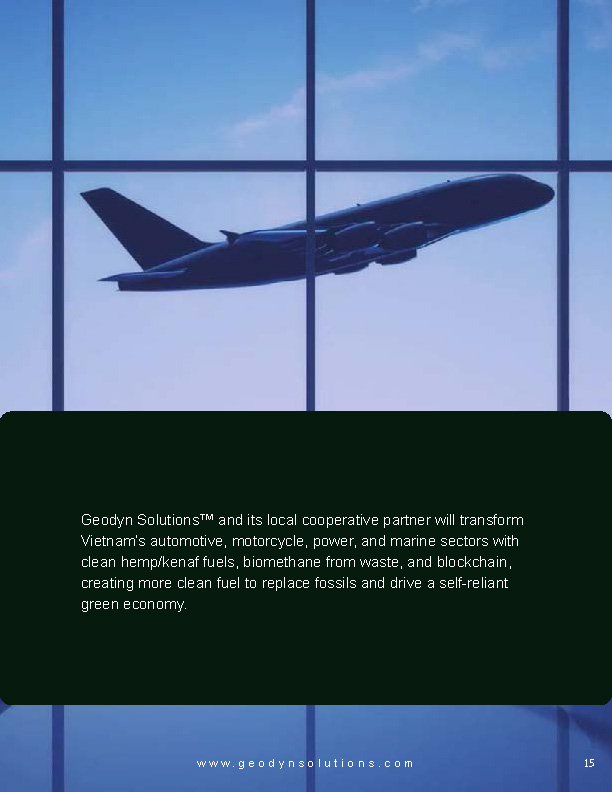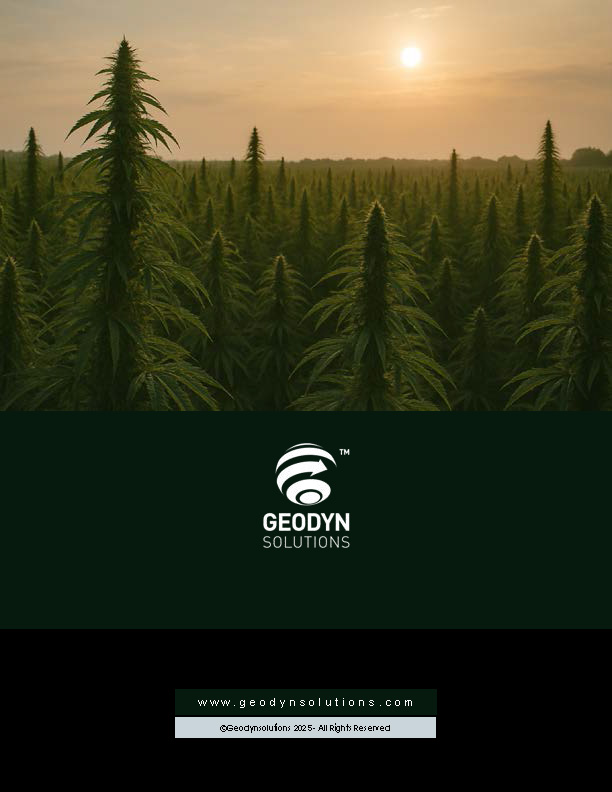Revolutionizing Vietnam's Automotive, Motorcycle, Power, and Marine Sectors with Geodyn Solutions™ Clean Hemp/Kenaf Fuel Technology, Biomethane from Waste, and Blockchain Integration
Geodyn Solutions™, a leader in advanced biofuel and microbial biotechnology, proposes a $250 million integrated project to deploy its proprietary Total Waste System™ (TWS™) and state-of-the-art biofuel technologies, all trademarked under Geodyn Solutions™, in Vietnam. In partnership with a local renewable energy cooperative, this initiative will cultivate hemp or kenaf (if hemp regulations are restrictive) on 12,000 hectares in Can Tho, southern Vietnam, process it into clean fuels (biodiesel, bioethanol, biogas, solid biofuels), and produce biomethane from agricultural and livestock waste. The project integrates these fuels into Vietnam’s automotive, motorcycle, power plant, and marine sectors, complemented by a Geodyn Blockchain Platform™ (GBP™) for supply chain transparency and tokenized carbon/energy assets. Leveraging all plant components, waste streams, and 2025 advancements like biofilm-based Anaerobic Moving Bed Biofilm Reactors (AnMBBR™) and CRISPR-enhanced enzymes, the project targets a robust 35-45% ROI over 5 years, with profits reinvested to scale production, creating more clean fuel to replace up to 10% of fossil fuel use by 2030 and 20-25% by 2035. The project will create 5,500 jobs and reduce CO₂ emissions by 1.2 million tons annually, plus additional GHG reductions from biomethane (up to 148.4 Mt CO₂-eq by 2050 potential nationwide). The $250 million budget includes a 15% contingency ($32.6 million). By addressing motorcycles, power, and marine needs alongside cars, and offering kenaf as a fallback, this proposal ensures compatibility with Vietnam’s transport and energy demands, outperforming fossil fuels, hydrogen, and ammonia in feasibility.
Introduction
Vietnam’s automotive and motorcycle industries are thriving, with 2025 sales projected to grow due to economic expansion and green incentives. Motorcycles, comprising over 80% of vehicles, dominate mobility but face fossil-fuel bans in cities like Hanoi by 2026 to curb pollution. Vietnam’s power sector relies heavily on coal, but the revised Power Development Plan VIII (PDP8) targets 30-39% renewables by 2030 and net-zero by 2050. The marine sector, vital for shipping and fishing, seeks green fuels under the 2025 Emissions Trading Scheme (ETS) pilot and IMO measures. Hemp, and kenaf as a regulatory-compliant alternative, offers a sustainable feedstock for clean fuels, while biomethane from abundant agricultural and livestock waste (e.g., pig manure, rice residues) provides a low-cost, scalable complement, potentially reducing GHG emissions by 50.4–148.4 Mt CO₂-eq between 2020 and 2050. Partnering with a local renewable energy cooperative in Can Tho leverages the Mekong Delta’s fertile land, waste resources, and community expertise. A mature hemp industry will yield benefits like medicine, water/flame/bacteria-resistant materials, building products, paper, cloth, animal feed, and protein. Vietnam’s 2025 Law on Digital Technology Industry legalizes crypto assets and supports blockchain, enabling the Geodyn Blockchain Platform™ for transparency and tokenization. All technologies are proprietary to Geodyn Solutions™, protected by trademarks and copyright © 2025.
Technology Description
Geodyn Solutions™ offers the Total Waste System™ (TWS™), a patented platform converting biomass into green diesel, syngas, and high-energy pellets in under 30 minutes (20 tons/hour capacity). The Microbial Biofilm Reactor™ (MBR™), incorporating AnMBBR™ technology, produces biogas with 96%+ methane purity, outperforming traditional digesters by 30%. Biomethane production from waste is integrated via enhanced anaerobic digestion of agricultural residues (e.g., rice straw, livestock manure), yielding 0.20-0.40 m³/kg of waste with low-cost feedstocks. Additional 2025 innovations, all trademarked under Geodyn Solutions™, include:
- CRISPR-Enhanced Enzymatic Hydrolysis™: Genetically optimized cellulase enzymes break down lignocellulose 40% faster, boosting bioethanol yields to 1,200 liters/hectare.
- Microwave-Assisted Pyrolysis™ with Carbon Capture: Produces syngas and biochar from hurd, reducing emissions by 15%.
- Nanofiltration Biodiesel System™: Purifies seed oil biodiesel with 60% less water, meeting ASTM D6751 standards.
- Geodyn Blockchain Platform™ (GBP™): Built on energy-efficient blockchains (e.g., Algorand or Vietnam’s emerging infrastructure), it ensures supply chain traceability and tokenizes carbon/energy assets for trading and investment.
- Biomethane Upgrading Units™: Upgrades biogas to biomethane (>95% purity) using pressure swing adsorption or membrane separation, tailored for Vietnam’s waste potential.
These technologies, © 2025 Geodyn Solutions, apply to hemp, kenaf, and waste streams. All plant parts and waste are utilized:
- Seeds: Biodiesel (800 liters/hectare) for marine engines and power backups.
- Stalks/Fibers: Bioethanol, biogas, or composites for vehicle parts (reducing weight by 15%).
- Hurd/Waste: Syngas, pellets, biomethane, or biochar for power plant co-firing.
- By-Products: Fertilizers, animal feed, textiles.
Blockchain and Token Integration
The GBP™ enhances the project by:
- Supply Chain Traceability: Immutable ledger tracking hemp/kenaf/waste from Can Tho farms to processing, ensuring THC compliance and sustainability certification via smart contracts.
- Tokenization:
- Carbon Tokens: Tradable tokens for 1.2 million tons CO₂ reductions annually (plus biomethane’s high GHG savings), generating $10-20 million/year.
- Energy Asset Tokens: Fractionalize biofuel/biomethane facilities or outputs (e.g., biogas for power plants), attracting investors.
- Utility Tokens: Reward farmers/partners via smart contracts, streamlining payments.
- Revenue and Reinvestment: 20% of token revenues ($5-10 million/year) reinvested into GBP™ expansion, scaling tokenized clean fuel assets.
Comparison with Fossil Fuels, Hydrogen, and Ammonia
The table compares hemp/kenaf biofuels and biomethane with alternatives in Vietnam’s automotive, motorcycle, power, and marine contexts.
Fuel Type | Adoption in Vietnam (2025) | Feasibility for Automotive/Motorcycles/Power/Marine | Pros | Cons |
Hemp/Kenaf Biofuels & Biomethane | Emerging; E5/E10 blends, biomass co-firing tests, marine pilots; biogas from waste expanding. | High; compatible with engines/carburetors (B20, E10), pellets/biomethane for co-firing, biodiesel for ships. | Renewable, 50-80% lower emissions, high yields (10-15 tons/hectare for biomass, 0.20-0.40 m³/kg waste), affordable, self-reliant. | Hemp regulatory hurdles (kenaf alternative); scaling needs investment. |
Fossil Fuels | Dominant; powers 90%+ vehicles, coal in power, marine bunkers. | High; reliable, but urban bans and ETS loom. | Low cost ($0.50-0.80/liter), established infrastructure. | High emissions, import dependency, non-renewable. |
Hydrogen | Limited; pilots in heavy-duty/marine, no widespread use. | Moderate; needs fuel cells/stations; challenging for motorcycles/power backups. | Zero tailpipe emissions, aligns with 2050 goals. | High costs ($5-10/kg), infrastructure gaps. |
Ammonia | Nascent; marine/power co-firing, minimal road use. | Low; toxic, needs modifications, unsuitable for motorcycles. | High energy density, uses LNG infrastructure. | Corrosive, high conversion costs. |
Biofuels and biomethane offer superior near-term feasibility, supporting Vietnam’s net-zero and ETS goals.
Project Scope and Implementation Plan
The project will establish a 12,000-hectare hemp/kenaf cultivation network in Can Tho, waste collection systems from local farms, and a nearby processing facility. Phases:
- Year 1 (2026): Land acquisition, pilot TWS™/AnMBBR™ plant (1,000 hectares), biomethane digesters, GBP™ setup, regulatory assessments.
- Year 2-3 (2027-2028): Scale to 12,000 hectares, deploy full facility producing 60 million liters of biofuel and 50 million m³ biomethane annually.
- Year 4+ (2029 onward): Integrate fuels into automotive/motorcycle supply chains, power plants (co-firing), marine bunkering, and export surplus.
If hemp’s THC regulations pose hurdles, kenaf ensures compliance with similar yields. Profit reinvestment will expand to power and marine applications, creating more clean fuel to replace fossil imports.
Capital Expenditure (CapEx) Breakdown
The $250 million CapEx includes a 15% contingency ($32.6 million).
Category | Cost ($M) | Description |
Land & Cultivation Setup | 60 | 12,000 hectares, irrigation, seeds (hemp/kenaf), waste collection systems. |
Processing Facility | 100 | TWS™, AnMBBR™, enzymatic hydrolysis, pyrolysis, nanofiltration, biomethane upgrading units. |
Infrastructure & Logistics | 42 | Roads, storage, transport, fuel blending stations. |
R&D and Training | 18 | Technology optimization, CRISPR, workforce training. |
Blockchain Integration | 13 | GBP™ development, smart contracts, tokenization infrastructure. |
Regulatory & Environmental Compliance | 12 | Permits, assessments, certifications. |
Working Capital & Miscellaneous | 5 | Initial operations, marketing, cooperative integration. |
Total | 250 | Includes 15% contingency. |
Financial Projections and ROI Optimization
Annual revenue: $180 million (fuel sales at $1.10/liter), $60 million (co-products), $30 million (carbon credits), $15 million (tokenized assets), $20 million (biomethane sales at $0.40/m³). Operating costs: $115 million/year. Net profit: $190 million/year post-Year 3. ROI: 35-45% over 5 years (breakeven Year 2), driven by high yields, tokens, and incentives. EROI: ~5:1.
Profit Reinvestment Strategy: 60% of profits ($114 million/year) reinvested into:
- Expanding cultivation to 24,000 hectares and waste processing capacity, producing 120 million liters of biofuel and 100 million m³ biomethane by Year 5.
- Upgrading TWS™ to 40 tons/hour and GBP™ for broader tokenization.
- Developing dedicated biofuel/biomethane lines for power plants (pellets/biomethane for 10% coal replacement) and marine (biodiesel blending), targeting 10% fossil fuel replacement by 2030 and 20-25% by 2035, reducing Vietnam’s $15 billion annual fossil import bill.
Job Creation
5,500 jobs: 3,200 in cultivation/waste collection, 1,800 in processing, 400 in R&D/logistics (including blockchain specialists), 100 in administration. Indirect: 2,500 in supply chain.
Environmental Benefits
- Emission reductions: 1.2 million tons CO₂/year offset (70% vs. fossils), plus biomethane’s potential for 50.4–148.4 Mt CO₂-eq nationwide by 2050.
- Sustainability: Low water/pesticides, soil remediation, 18 tons CO₂/hectare sequestered.
- Circular economy: Biochar/fertilizers/digestate from residues and waste.
Broader Benefits of a Mature Hemp Industry
A mature hemp industry will diversify Vietnam’s economy:
- Medicine: CBD for pain, inflammation, anxiety, epilepsy.
- Water/Flame/Bacteria Resistance: Fibers for textiles, coatings, gear.
- Building Materials: Hempcrete for eco-friendly construction.
- Paper: Sustainable pulp for paper, packaging.
- Cloth/Textiles: Breathable fabrics for clothing, exports.
- Animal Feed/Protein: Nutrient-rich seeds/leaves.
Thousands of Hemp Uses
Hemp’s 25,000+ applications include:
- Fiber/Textiles: Clothing, ropes, sails, canvas, upholstery, carpets, geotextiles, insulation, fire/water/bacteria-resistant materials.
- Building/Construction: Hempcrete, fiberboard, insulation, roofing, flooring, biodegradable plastics, composites.
- Paper/Packaging: Printing paper, cardboard, tissue, newsprint.
- Food/Nutrition: Seed oil, protein powder, flour, milk alternatives, snacks, animal feed, birdseed.
- Medicine/Health: CBD oils, tinctures, topicals, pharmaceuticals, cosmetics, soaps, shampoos.
- Fuel/Energy: Biodiesel, bioethanol, biogas, pellets, syngas, biochar.
- Industrial: Paints, varnishes, inks, lubricants, sealants, adhesives, detergents, absorbents, mulch.
- Agriculture/Environment: Soil remediation, weed suppression, crop rotation, animal bedding, composting.
- Other: Musical instruments, jewelry, toys, sports equipment, batteries, supercapacitors, nanotechnology.
Risks and Mitigation
- Regulatory: Hemp restrictions mitigated by kenaf option; blockchain compliance via sandbox testing; biomethane supported by PDP8 incentives.
- Market: Volatility hedged by diversification and contracts.
- Technical: Scaling covered by contingency and phased rollout.
Conclusion and Call to Action
Geodyn Solutions™ and its local cooperative partner will transform Vietnam’s automotive, motorcycle, power, and marine sectors with clean hemp/kenaf fuels, biomethane from waste, and blockchain, creating more clean fuel to replace fossils and drive a self-reliant green economy. We invite stakeholders to collaborate.
